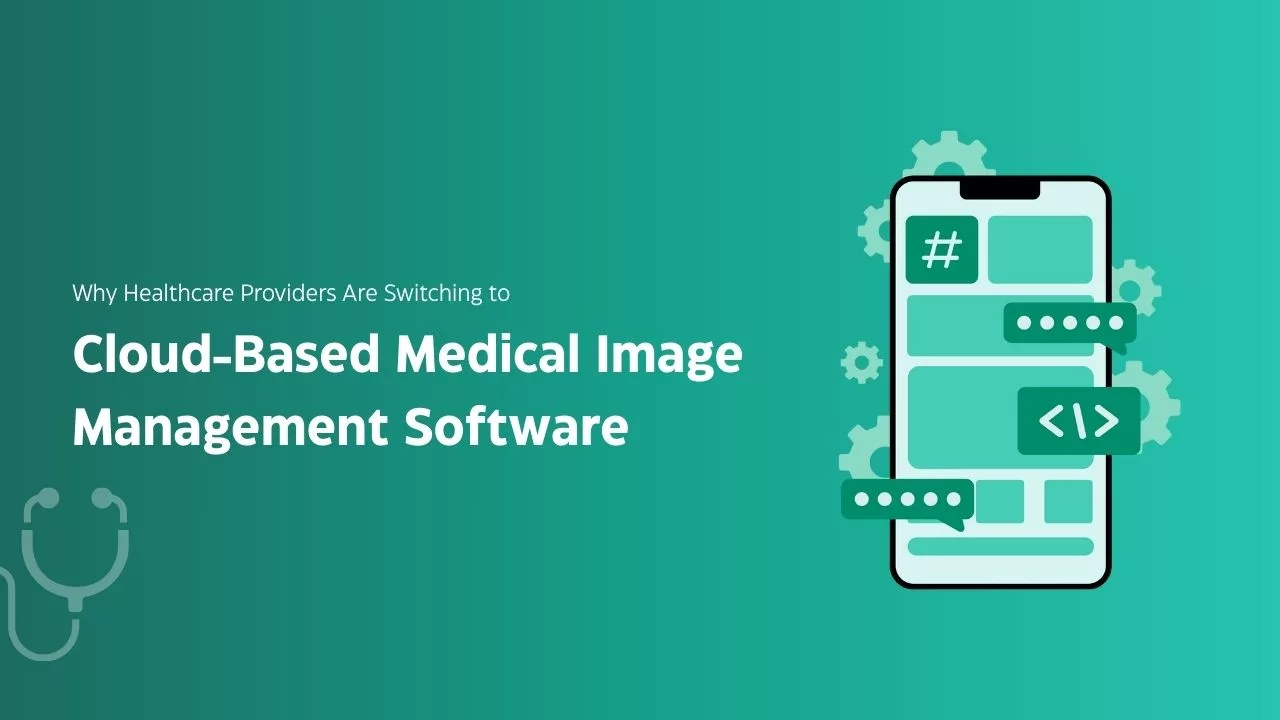Cloud-based medical image management is rapidly reshaping how healthcare organizations store, access, and share diagnostic images.
Healthcare leaders are actively searching for faster, more cost-effective, and clinically efficient ways to manage growing imaging volumes. This shift toward cloud systems is driven by the need for better collaboration, more scalable infrastructure, and improved patient outcomes—all without the limitations of traditional on-premise solutions.
In this article, you will learn:
- how cloud platforms streamline imaging workflows
- why scalability and cost efficiency matter more than ever
- what features modern providers should demand in a cloud solution
By the end of this guide, you’ll understand why cloud imaging has become the new standard—and what it means for the future of patient care.
The Rise of Cloud-Based Medical Image Management
For decades, medical image management revolved around on-premise Picture Archiving and Communication Systems (PACS). These systems required large server rooms, dedicated hardware, complex maintenance routines, and constant updates—creating significant friction for both IT teams and clinical staff. As imaging volumes increased, traditional PACS often struggled to scale, leading to slow retrieval times, storage shortages, and workflow bottlenecks across radiology, cardiology, and other departments.
At the same time, healthcare organizations began facing new pressures: multisite expansion, rising interoperability demands, remote radiology workflows, and the need for secure access from any location. These forces exposed the limitations of legacy systems and made the cloud an increasingly attractive alternative.
Cloud-based medical image management emerged as a modern solution that eliminates physical storage constraints, offers real-time accessibility, and provides baked-in security features—aligning perfectly with the digital transformation goals of today’s healthcare providers.
Core Benefits of Cloud-Based Medical Image Management
A. Instant Scalability and Storage Flexibility
Medical imaging volumes grow every year, driven by higher utilization of CT, MRI, ultrasound, and digital pathology. Cloud platforms solve the storage challenge by offering virtually unlimited capacity that automatically expands with demand. Health systems no longer need to predict future storage needs, replace aging hardware, or endure downtime during upgrades. For multisite organizations, this elasticity ensures every facility—large or small—can access the same robust imaging infrastructure without managing its own servers.
B. Faster, More Collaborative Clinical Workflows
Cloud-based imaging removes the physical barriers of traditional PACS. Radiologists can open images from anywhere, surgeons can review scans in real time before procedures, and remote specialists can consult without waiting for CDs or manual transfers. This improved accessibility accelerates diagnosis, supports cross-department collaboration, and enables smoother transitions between emergency, inpatient, and outpatient care settings.
C. Lower IT Costs and Operational Burden
On-premise systems require constant attention: maintenance, patching, hardware refreshes, storage expansion, and energy consumption. Cloud-based systems shift these responsibilities to the vendor, reducing internal IT workload and eliminating unexpected hardware expenses. With predictable subscription pricing, organizations gain long-term cost clarity and freedom from managing physical infrastructure.
D. Improved Security and Compliance
Cloud vendors invest heavily in cybersecurity—far more than most individual hospitals can on their own. Built-in encryption, 24/7 monitoring, automated backups, disaster recovery, and comprehensive auditing help ensure data integrity and HIPAA compliance. Modern cloud platforms also centralize governance, making it easier to implement standardized policies across all facilities and departments.
For healthcare organizations exploring modern imaging technology, partnering with a trusted cloud imaging provider is essential. Platforms like darly.solutions help streamline storage, improve accessibility, and enhance workflow efficiency with secure, cloud-first medical image management tools. Their solutions are built to support scalability, clinical collaboration, and regulatory compliance—making them a strong option for providers transitioning away from legacy PACS.
How Cloud Imaging Transforms Patient Care
Cloud-based medical image management isn’t just an IT upgrade—it directly influences clinical outcomes. By eliminating delays in image retrieval and enabling instant access from any location, cloud systems help physicians diagnose patients faster and with greater confidence. This reduces wait times, accelerates treatment decisions, and minimizes the risk of duplicated or unnecessary imaging exams.
Improved accessibility also strengthens continuity of care. Whether a patient moves between emergency, inpatient, outpatient, or specialist settings, their imaging history follows them seamlessly. Clinicians gain a complete, accurate view of the patient’s journey, which leads to more informed decision-making and fewer gaps in communication.
Additionally, cloud imaging opens the door to broader expertise. Remote radiologists, subspecialty consultants, and telehealth providers can review cases without technical barriers. This makes second opinions easier, supports understaffed facilities, and expands access to high-quality care—regardless of geography.
Also look at 40 Premier Healthcare Software Development Companies in 2025: Expert Reviews & Insights
Common Hesitations (and Why They’re Fading)
Even as cloud-based medical image management gains traction, some healthcare leaders still express concerns rooted in past experiences with early cloud technologies. One common hesitation involves data migration—moving years or decades of imaging studies into a new system can feel daunting. However, modern vendors now offer structured migration frameworks, phased transitions, and automated integrity checks that dramatically reduce risk and downtime.
Another concern is the perceived loss of control over data. Many organizations worry that storing images off-site means relinquishing ownership. In reality, reputable cloud providers design their systems so the healthcare organization retains full data control, with customizable access rules, comprehensive audit trails, and clear governance policies.
Some decision-makers also cite fears around latency, uptime, or cybersecurity. Yet advances in network reliability, global data center redundancy, and real-time encryption have largely eliminated these issues. Today’s cloud platforms consistently deliver faster performance, higher uptime, and stronger security than most on-premise environments—making old fears increasingly irrelevant.
Also read: How to Develop a Secure Strong Mobile Healthcare App?
What to Look For in a Cloud-Based Medical Image Management Solution
Choosing the right cloud-based medical image management platform requires more than simply moving data off-site—it demands a system that enhances clinical efficiency, supports interoperability, and strengthens data governance. One of the first features to look for is a zero-footprint viewer, which allows clinicians to open images from any device without installing local software. This ensures smooth access across specialties, facilities, and telehealth environments.
Modern platforms should also offer AI-driven tools such as automated measurements, triage prioritization, or anomaly detection. These capabilities not only accelerate clinical reviews but also help reduce diagnostic variability. Strong interoperability is equally essential. The solution should integrate seamlessly with EHRs, RIS systems, and third-party imaging tools through standards like DICOMweb, HL7, and FHIR.
On the operational side, evaluate the vendor’s track record in security, compliance, and uptime. Healthcare organizations need clear evidence of HIPAA alignment, encryption standards, SOC 2 certifications, and disaster recovery architecture. Finally, ask strategic questions regarding scalability, data portability, customer support, and long-term roadmap—ensuring the system can evolve with your organization’s future needs.
Also read: The Role of Blockchain in Healthcare Industry: Trends, Market Statistics
Conclusion
Cloud-based medical image management has quickly become a cornerstone of modern healthcare because it delivers what traditional systems cannot: faster workflows, scalable infrastructure, and stronger security. Throughout this article, you’ve seen how cloud imaging streamlines clinical collaboration, reduces operational burden, and ultimately improves patient care through instant access and greater continuity.
The three biggest takeaways are clear:
- Cloud platforms dramatically enhance workflow speed and collaboration.
- Scalability and predictable costs solve long-standing IT challenges.
- Built-in security and compliance make cloud systems safer and more reliable than legacy PACS.
As more healthcare organizations embrace digital transformation, cloud-based imaging is shifting from a competitive advantage to an industry standard. If you’re exploring next steps, a natural place to go from here is learning how to evaluate and compare top cloud-based PACS vendors. Understanding the differences between platforms will help you make a more confident, future-proof decision.









Leave a Reply